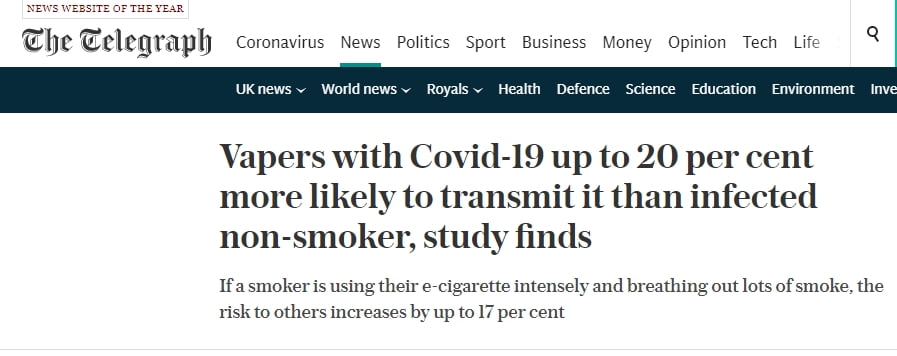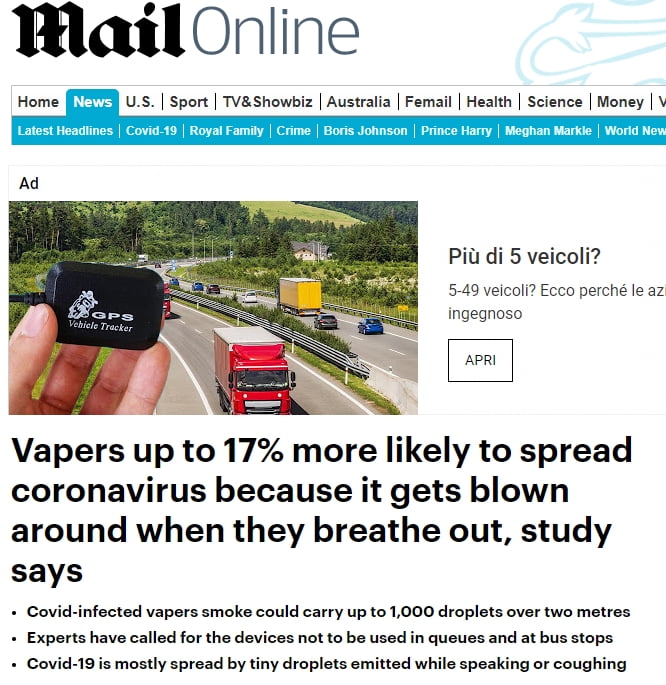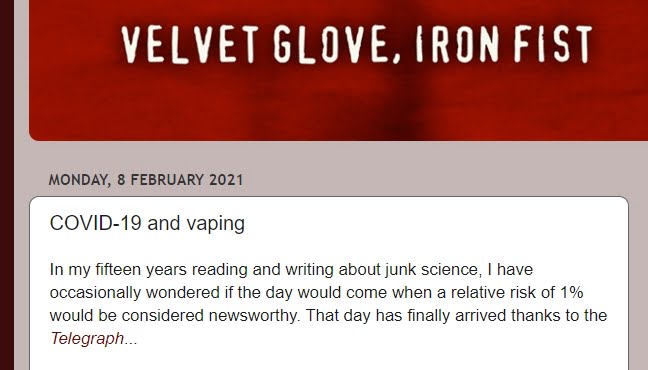(By Catania Conversation) Could an increase of 1% reported by a study obtain a dramatic headline in well-known international newspapers?
The answer seems to be positive if it comes to demonise anything related to e-cigarettes.
The incriminated figure appears in a pre-print study: “Aerial Transmission of the SARS-COV-2 Virus through Environmental E-Cigarette Aerosol: Implications for Public Policies” by Dr Roberto Sussman, Prof. Riccardo Polosa, Eliana Golberstein.
The aim of the study was to measures how much vapers exhale compared to non-vapers, and if this had any consequences in the spreading of Covid-19. Research also would “contributes to the setting up of guidelines for public policies on vaping and smoking in the context of containment, prevention and mitigation strategies in the COVID-19 pandemic.“
The result showed as for most of the users in the act of vaping the risk increased by just 1% in indoor places. In some cases, the risk went up to 17% for high-powered devices. But such devices are only used by 10% of vapers.
For comparison, the study explained how the risk increases by 176% for speaking and by 260% for coughing every two minutes in an hour.

As the study underlined, expirations by vaping produce a visible cloud easily avoided by others. This implies that outside this particular area of infection risk is negligible.
The conclusion from the researcher is that vaping does not require particular interventions other than social distance and the use of protective masks.
This came while the U.S. Centers for Disease Control and Prevention (CDC) step back from its previous statement, which suggested e-cigarettes increase risks. The new assessment, in particular, no longer includes the general recommendation to stop vaping.
“The research was due to improve the policies to curb the pandemic and avoid any unreasonable panic among the population” said Prof. Riccardo Polosa, one of the authors of the study.
Nevertheless, The Telegraph decided to publish an article with the headline “Vapers with Covid-19 up to 20 per cent more likely to transmit it than infected non-smoker, study finds” misquoting the study and spreading unreasonable fears.

“Misinterpreting maliciously scientific work is counterproductive. It destroys and undermines the hard work that many scientists have to do every day to unravel and uncover universal truths, accommodating a half truth to your narrative is as bad as lying rampantly or spreading conspiracy theories” said one of the researcher Eliana Golberstein.
The British tabloid “The Daily Mail” chose the headline, “Vapers up to 17% more likely to spread coronavirus because it gets blown around when they breathe out, study says” falsely claimed the study endorsed ban in restaurants and train stations.

In response Dr Roberto Sussman, leading researcher of the study, on Twitter:

Chris Snowdon (Institute of Economic Affairs, UK) in his blog Velvet Glove also criticised the articles by The Telegraph and the Daily
Mail.

The United Kingdom has been on the frontline for Tobacco Harm Reduction and safer alternatives to traditional cigarettes. With seven million people using e-cigarettes the UK is also the leading country in Europe for number of vapers, although there are still 73,000 deaths and 480,000 hospital admissions every year.
Accurate information based on scientific evidence is an undeniable right to all smokers willing to quit or to switch to safer alternatives.
Sparking fear with sensationalistic journalism will do more harm than good, limiting the effectiveness of Public Health policies able to reduces the burden on the various National Health System from smoking illness.
“The article by The Telegraph aims only to spread misinformation and isn’t based on science. Once again, we are witnessing bias by media towards the world of vaping”- leading scientist on Tobacco Harm Reduction and Founder of CoEHAR Prof. Riccardo Polosa- speaks out commenting on the headline.





